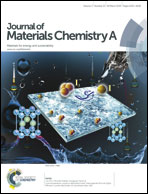The vapour phase detection of explosive markers and derivatives using two fluorescent metal–organic frameworks†
Abstract
Two fluorescent metal–organic frameworks (MOFs) [Zn(dcbpy)(DMF)]·DMF and [Dy(dcbpy)(DMF)2(NO3)] (dcbpy = 2,2′-bipyridine-4,4′-dicarboxylate) were synthesised solvothermally and structurally characterised. Uniform shape and sized microcrystals of [Zn(dcbpy)(DMF)]·DMF were also produced using microwave synthesis. The frameworks give organic linker-based fluorescence emission and demonstrate very different detection capabilities towards the explosive taggant 2,3-dimethyl-2,3-dinitrobutane (DMNB) and trinitrotoluene (TNT) derivatives; 2,4-dinitrotoulene (2,4-DNT), nitrobenzene (NB) and para-nitrotoluene (p-NT). These differences are attributed to the variation in the overall framework architecture between the two MOFs. This paper reiterates the key importance of MOF porosity in sensing applications, and highlights the value of uniform microcrystals to sensitivity.

- This article is part of the themed collection: Highlighting materials research in the UK for energy and sustainability

 Please wait while we load your content...
Please wait while we load your content...